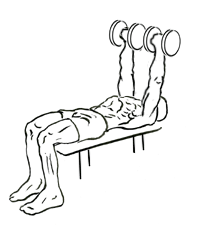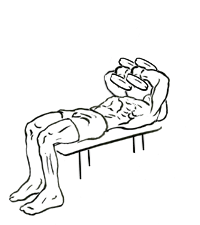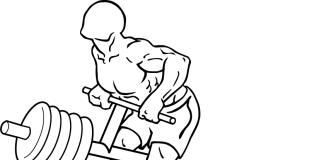Last Updated on September 26, 2014
The Tate Press is an advanced tricep exercise that requires controlled movement and focuses specifically on engaging the triceps differently than standard pressing exercises like skull crushers or tricep extensions. It’s a powerful way to add definition and size to the triceps, especially in the long head of the muscle, giving the arms a fuller appearance.
This exercise is not often seen in beginner routines because it requires a fair bit of coordination and control, but with practice, it can become a mainstay for anyone serious about building stronger, more defined arms.
Benefits of the Tate Press
- Targeted Triceps Development: The Tate Press isolates the triceps, particularly the long head, helping to build strength and size in the back of the arms.
- Improves Arm Stability: By challenging stability in the elbow joint, the Tate Press strengthens the arm in a unique way, which can benefit other pressing exercises.
- Different Angle for Tricep Engagement: This movement works the triceps from a unique angle, maximizing muscle activation and preventing workout plateaus.
- Enhanced Upper Body Aesthetics: Strong, defined triceps add to overall arm appearance, balancing out bicep-focused exercises and enhancing the “horseshoe” shape of the triceps.
Step-by-Step Guide: Performing the Tate Press
Let’s go through each phase of the Tate Press to ensure proper form and execution. Following these steps will maximize tricep engagement and minimize the risk of injury.
1. Setting Up the Equipment
- Bench: Find a flat bench for stability. Lying flat allows you to focus on the triceps without needing to stabilize your upper body as much.
- Dumbbells: Choose a manageable weight to start, as the Tate Press is all about controlled motion. Using weights that are too heavy can compromise form and place stress on the elbows and wrists.
2. Starting Position
- Lie Flat on the Bench: Position yourself on the bench with your back flat, head resting at one end, and feet firmly planted on the floor. Your feet should be shoulder-width apart for stability.
- Grip the Dumbbells: Hold a dumbbell in each hand with your palms facing your feet. This position may feel different from a traditional grip, but it’s essential for targeting the triceps effectively in this exercise.
- Position the Weights at Chest Level: Bring the dumbbells up to your chest, keeping your elbows pointed outward. Your upper arms should remain perpendicular to your torso throughout the movement.
3. Executing the Movement
- Engage Core and Stabilize Elbows: Draw your abs in and press your back into the bench. Your elbows should be stable and positioned outward, not dropping below shoulder height.
- Raise the Dumbbells: Without moving your elbows, push the dumbbells upward and slightly outward. As you do so, focus on contracting your triceps. The weights should move in an arc-like motion, not a straight line.
- Squeeze the Triceps: At the top of the movement, squeeze your triceps and pause briefly to maximize muscle engagement.
- Controlled Lowering: Slowly lower the dumbbells back to the starting position, focusing on keeping your elbows steady. This controlled lowering phase keeps tension in the triceps, making the exercise more effective.
4. Breathing Technique
- Inhale as you lower the dumbbells back down to your chest.
- Exhale as you push the dumbbells back up, focusing on stabilizing your core.
Muscles Targeted in the Tate Press
The Tate Press primarily works the triceps brachii, which has three heads: the long head, the lateral head, and the medial head. Let’s break down how each head is engaged:
- Long Head: The Tate Press is particularly effective at targeting the long head of the triceps, which is crucial for overall tricep thickness.
- Lateral Head: This head is also activated, though it is less engaged than in exercises like tricep kickbacks.
- Medial Head: The medial head assists in the movement, though it plays more of a stabilizing role.
- Forearms: While the triceps are the main focus, your forearm muscles help to stabilize the dumbbells during the movement.
- Shoulders: Although the shoulders are not the primary muscle group worked, they provide support to maintain the elbow position and keep the weights controlled.
Understanding these muscles will help you visualize which areas to focus on during the exercise, ensuring better form and greater activation of the triceps.
Common Mistakes and How to Avoid Them
Mastering the Tate Press requires attention to form, as improper technique can lead to ineffective muscle engagement or even injury. Here are some common mistakes and how to avoid them:
- Using Excessive Weight: This exercise requires control and stability rather than brute strength. Lifting too heavy compromises form and may strain your elbows or shoulders.Tip: Start with lighter weights and gradually increase as you master the movement.
- Dropping the Elbows: Allowing your elbows to fall below shoulder height reduces tricep engagement and shifts the focus away from the targeted muscle.Tip: Keep your elbows pointing outward and avoid letting them drop as you perform the movement.
- Moving the Elbows: The elbows should remain stationary throughout the exercise. Moving them too much shifts the load from the triceps to the shoulders, reducing the exercise’s effectiveness.Tip: Focus on keeping your upper arms steady and only moving your forearms to lift the weights.
- Rushing the Movement: Performing this exercise too quickly can cause you to lose control, which reduces muscle activation and increases the risk of injury.Tip: Use a slow and controlled tempo, focusing on squeezing the triceps at the top of each repetition.
Tips for Maximizing the Tate Press
- Focus on the Mind-Muscle Connection: Actively concentrate on your triceps throughout the movement. This mental focus will help you achieve better muscle activation and more significant results.
- Use a Full Range of Motion: Move the weights in a controlled arc, allowing a full stretch at the bottom and a strong contraction at the top.
- Try a Slight Pause: At the top of the movement, pause for a moment to fully contract the triceps before slowly lowering the weights. This extra hold enhances the burn and maximizes muscle activation.
- Tempo Variations: Occasionally slow down both the lifting and lowering phases to increase time under tension, which can lead to improved muscle growth.
- Incorporate into a Tricep Superset: The Tate Press is a great exercise to add into a superset or circuit with other tricep movements, like tricep pushdowns or close-grip bench presses, to fully fatigue the triceps.
Variations of the Tate Press
- Single-Arm Tate Press: Perform the Tate Press one arm at a time to correct any muscle imbalances and focus on each tricep individually.
- Incline Tate Press: Perform the exercise on an incline bench to change the angle of the movement, which places a slightly different emphasis on the triceps and challenges stability.
- Tate Press with Resistance Bands: If you don’t have access to dumbbells, you can use resistance bands to mimic the movement. This variation can be particularly useful for those training at home.
- Decline Tate Press: Using a decline bench allows you to target the triceps from a new angle, which may further enhance muscle activation.
- Tate Press on a Stability Ball: Performing the Tate Press while lying on a stability ball adds a core-stabilizing component, increasing the exercise’s difficulty and requiring greater balance.
Sample Workouts Incorporating the Tate Press
Here are some sample routines to incorporate the Tate Press into your workout:
Tricep-Focused Workout
- Close-Grip Bench Press: 3 sets of 8-10 reps
- Tricep Pushdown: 3 sets of 10-12 reps
- Tate Press: 3 sets of 12-15 reps
- Overhead Tricep Extension: 3 sets of 10-12 reps
Upper Body Strength Workout
- Bench Press: 4 sets of 6-8 reps
- Seated Dumbbell Shoulder Press: 3 sets of 8-10 reps
- Lat Pulldown: 3 sets of 10-12 reps
- Tate Press: 3 sets of 12 reps
- Hammer Curls: 3 sets of 10-12 reps
Arm Superset Workout
- Dumbbell Bicep Curl: 3 sets of 10-12 reps
- Tricep Pushdown: 3 sets of 10-12 reps
- Tate Press: 3 sets of 12-15 reps
- Reverse Curl: 3 sets of 12 reps
This structure helps keep your muscles engaged and promotes balanced arm development.
Frequently Asked Questions
1. Is the Tate Press suitable for beginners?
Not really; the Tate Press is generally recommended for advanced lifters who already have good control and tricep strength. Beginners may benefit from mastering simpler exercises first, like tricep pushdowns or overhead tricep extensions.
2. How much weight should I use for the Tate Press?
Start light. A moderate weight that allows for controlled movement is ideal. Trying to lift too heavy can lead to compromised form and even injury.
3. Can the Tate Press cause elbow pain?
If you experience elbow pain during the Tate Press, it may indicate that the weights are too heavy, or your form needs adjusting. Lowering the weight and focusing on a slow, controlled movement can reduce strain on the elbows.
4. How often should I include the Tate Press in my workout?
Since the Tate Press is a targeted tricep exercise, including it once or twice per week as part of an upper body or arm workout is ideal. Be mindful of rest and recovery, as overtraining can hinder results.
5. What’s the best grip to use for the Tate Press?
The traditional overhand grip (palms facing feet) is best for maximizing tricep engagement in the Tate Press. It helps keep the focus on the triceps and ensures correct form.
Final Thoughts
The Tate Press is a unique and challenging exercise that can significantly enhance your triceps workout routine. By focusing on controlled movement, form, and proper muscle activation, you can maximize the benefits of this exercise and improve your upper body strength and aesthetics. Remember to start light, maintain a steady tempo, and consider pairing it with other tricep exercises for a well-rounded approach to arm training. With consistent practice and attention to form, the Tate Press can become a powerful tool in building strong, defined triceps.


Exercise images by Everkinetic.






